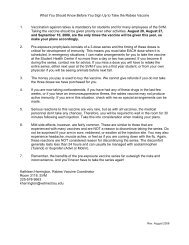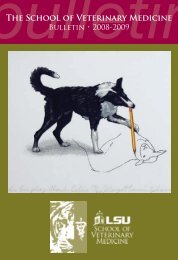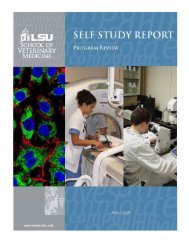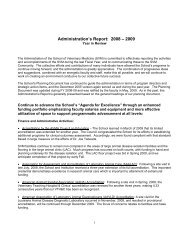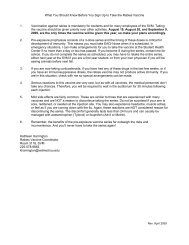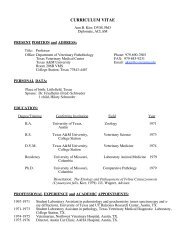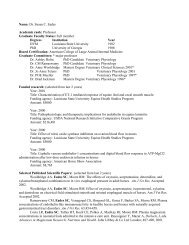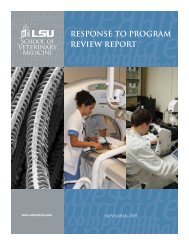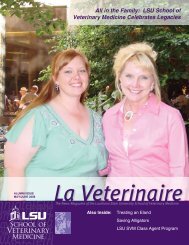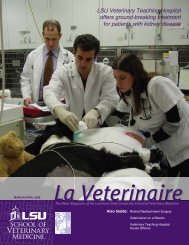2006 merck/merial - School of Veterinary Medicine - Louisiana State ...
2006 merck/merial - School of Veterinary Medicine - Louisiana State ...
2006 merck/merial - School of Veterinary Medicine - Louisiana State ...
Create successful ePaper yourself
Turn your PDF publications into a flip-book with our unique Google optimized e-Paper software.
Variation in Q-Tract Length <strong>of</strong> the Androgen Receptor Influences Initiation and Progression <strong>of</strong>Prostate Cancer in Humanized AR Mice.MA Albertelli1,2, A Scheller1, M Brogley1, DM Robins1.1Department <strong>of</strong> Human Genetics and 2Unit for Laboratory Animal <strong>Medicine</strong>, University <strong>of</strong> Michigan Medical <strong>School</strong>, AnnArbor, MI 48109Androgen receptor (AR) is required for development <strong>of</strong> prostate tumors and androgen blockadeis a major component <strong>of</strong> prostate cancer treatment. Therefore, variation in AR function may impactprostate cancer risk and disease progression. The AR contains a polyglutamine (or Q) tract that varies inlength within the normal human population. The length <strong>of</strong> the polyglutamine tract has been shown toaffect AR function in cell culture, but the effect <strong>of</strong> this polymorphism in humans is controversial. Somestudies have shown that a shorter Q tract increases prostate cancer risk while other studies have shownno association. In order to overcome the variable genetic background and environmental factors thataffect human studies, our laboratory developed the humanized AR (h/mAR) mouse by replacing themouse AR (mAR) with human sequence (figure 1). Three lines <strong>of</strong> mice that differed in Q tract lengthwere created, containing 12, 21, or 48 glutamine residues.H/mAR mice were initially characterized by examining physiological traits in animals aged 6 to24 months. The mice were remarkably similar and did not significantly vary in androgen-influencedfeatures such as fertility, body weight, or body fat mass. 12Q-h/mAR mice did have significantly largerseminal vesicles (an androgen-dependent organ), but only in the oldest group. To investigate effect <strong>of</strong>the Q tract on AR activity, mRNA levels <strong>of</strong> several prostatic AR-regulated genes were assayed. Again,there were only small differences between the mouse lines, but in each case the expression patternconfirmed predictions <strong>of</strong> Q tract length effect on AR function (figure 2). Therefore, Q tract length doesnot significantly affect thephysiology <strong>of</strong> healthy mice, although small differences in AR-regulated genes may have significanteffects as they accumulate over a lifetime (as suggested by seminal vesicle weight); we hypothesizedthat these changes may also impact prostate cancer.To study prostate tumors in these animals, each h/mAR line was crossed to TRAMP, a mouseexpressing a viral oncogene in the prostate. In order to compare tumor growth in different hormonalenvironments, half <strong>of</strong> the progeny were hormonally intact, selecting for androgen dependent tumors,while half were castrated at 12 weeks <strong>of</strong> age (when early prostate cancer lesions are present) to select forandrogen-depletion resistant tumors. Tumor development was tracked by abdominally palpating eachmouse once per week and mice were euthanized when moribund. In hormonally intact animals, tumorswere first palpated at a similar age in 12Qh/mAR, 21Q-h/mAR and mAR alleles. However, tumordetection in 48Q-h/mAR mice was significantly delayed. Conversely, in castrated animals, 48Q-h/mARmice developed palpable tumors somewhat earlier than 21Q-h/mAR mice while tumors in 12Q-h/mARmice were detected at a significantly later age (figure 3). These findings support the conclusions <strong>of</strong> somehuman studies that AR Q tract length affects prostate cancer, but unexpectedly also show that this effectis inverted with hormone depletion.Subtle changes in AR function do not impact healthy mice but have significant effects whenthese mice develop prostate cancer, an androgen-dependent disease. H/mAR mice are a valuable modelto investigate the role <strong>of</strong> AR in prostate cancer and the mechanisms <strong>of</strong> androgen resistance, and in thefuture may be useful for testing new AR-targeted prostate cancer therapies.28



